These notes were compiled by myself throughout the workshop held July 2-3. I have done my best to recapture important topics, therefore any inaccuracies are entirely on my behalf. The notes are presented as they were written – chronological and point form.
Nomenclature
PC positive cirlce
NC negative circle
Front using spine as vertical demarcation line, side of body with arm doing circle
Top using hips as horizontal demarcation line, the trunk and upper extremeties
Most oft-repeated point by Master Chen: DON’T MOVE! Learn to lock point(s) in space/body and rotate everything else sequentially.
- Keep one pt. locked and rotate next pt.
- NC -> keep rear and front shoulders fixed before hand out; contain (concave) the front then rear chest areas before hand out
- Keep front kua always open and enlarged; do not collapse by leaning to the front or pointing the top to the floor
- If you can “feel” qi, then you are doing something wrong. Imagine electricity flowing through a wire: the greater the heat dissipated from the wire, the poorer the conductance. Better wire -> better conductance -> less heat felt. Likewise, better structure -> better energy transfer -> less qi felt.
- The best move is when you don’t know what happened; if you can explain it you could do something better
- Goal is to be precise, not strong – like a laser bomb as opposed to carpet bombing. Have to be able to control your body to refine focus proportional to or greater than opponent’s strength.
- Two kua exercises: a) use point of reference on waist line, like belt buckle, and twist waist as far as possible to get point as far as possible away from it’s original position, then shorten the distance, then lenghten – repeat cycle. Introduce restriction (fixed) points one at a time to increase difficulty, such as front knee, then rear knee, then front shoulder etc; b) keep one point fixed between one foot and ground; pick a dot in space in front of you, far enough away that your opposite kua could touch by pivoting on the fixed point. Then add restrictions like keeping other foot in place etc. In practice your front kua should always go into your opponent – these exercises help “liven” the kua.
- In practice, always keep ‘on’ on your opponent, meaning do not retreat. Your kua should always penetrate them. Do not penetrate with anything else; manipulate your body to penetrate your center into theirs.
- Fix two points and separate distance between them -> creates tension -> anywhere along this line lies power. Can do this on any points on your body and/or opponent. Best to start with protruding (extreme) outer points like feet, hands, head, shoulders etc. Concurrently, power should never be generated from any part of body other than the feet; partner should feel your body parts are relaxed. The choice of foot depends where you are in your circle or what your partner is doing. For instance, when doing PC, your front foot is the “power foot” on elbow in half; on hand out your rear foot becomes the “power foot”.
- Levels of taijiquan: first level is directional energy; second level is rotational energy which has no directions. Feeling is like you are in outerspace with no sense of up, down, left or right. If you get your opponent to fall to the ground, you have achieved the next dimension of taijiquan. All correct movements in taijiquan has this feeling of the unknown. If it feels good and nice, you are not doing it right yet. If it feels uncomfortable and scary, on the right track!
- When learning the form, you should practice the transition movements to get that feeling of the unknown – that point where you might or will fall over or it feels impossible to move into the next posture. There has to be that sensation of getting “sucked” into nothingness. Ideally your partner will feel this.
- PC: (Refer to latest video on NC’s). When elbow has been pressed against torso, before hand out, lock shoulder pt to use as pivot point rivoted in space; pivot elbow toward chest side of body on plane perpendicular to issuing force; choose two dots that contact each other, one on front chest and one on bicep; rotate bicep muscle towards torso which initiates hand rotation; concentrically separate the two dots -using shoulder pivot point – by concaving front chest away from bicep to create scissor-like action. This is a fundamental principle which can and should be applied to any points of the body, using 3 points (triangle). Most important thing for beginners is to learn to not move certain points while others move proportionally from it. We strive to achieve this on all 9 major points of the body in the beginning, but through refinement – proper effort – this number of relationships increase. Furthermore, there is one very important point that shares 5 points, creating a 5-way stretch, located approximately halfway between front shoulder-kua line.
- Do not move front shoulder-kua line
- Few personal corrections on circles from Master Chen:
- Stretch distance through body starts at stationary hand. In pushing, intent is on body movement, not hands. The actual body movements are not moving, they undergo pure rotation. Each individual rotation is actually just rotated by a hairline (minute).
- NO DRILLS! We do not drill anything.
- In taijiquan, the foot placement is key: it is not how you step e.g. set pattern, but where you place the foot.
- Personal observation: When watching Master Chen move against a partner, it appeared as as if he was penetrating close to your centre with his front foot – never giving up the position. He seems to slip in like a water over a slippery rock: without you knowing it at that instant, keeping a sound physical structure, then gets at least two arbitrary points of contact and uses a third (already placed foot) to serve you floor breakfast, lunch or dinner for free – the 3-way split! Master Chen explained in higher levels you do not need to worry about foot placement any longer; you choose 3rd dot anywhere.
- Your vector force is aimed at your partner, like a bow and arrow – beyond, behind or wherever you choose. It is not intent with the mind; your mind has nothing to do with it. Your mind just gives orders to flex muscles and other physiological phenomena. They – a generic Master – are not shooting out qi or some mysterious force. It is simply a physical (rigid-like) force, but a highly refined one at that -> pure mechanical.
- When pushing, decide 2 pts arbitrarily and draw line between them; must separate them to create tension. Decide on a 3rd pt on your body or on theirs and bring that point to the established line to break it. The 2 pts can be any pts of contact e.g. you grabbing him with 2 hands, your shoulder and hand, both his hands grabbing you etc. The 3rd pt has to come from you i.e. could be your kua, your shoulder, peck, whatever… you just bring it to the line established by the 2 pts to snap it.
- 5 pts is taiji
- Master Chen drew this diagram:
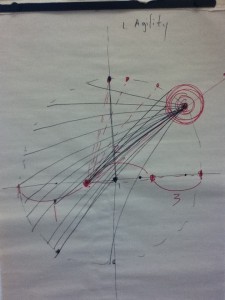 Re. above diagram:
Re. above diagram:
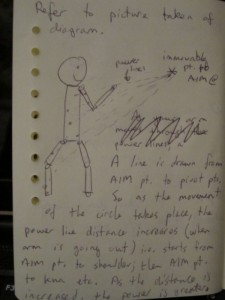 The max distance is when the power line reaches the rear foot.
The max distance is when the power line reaches the rear foot. - In pushing, true revolution (hand) plus rotation (waist) is unstoppable power.
- Pushing practice -> from Master Chen to me:
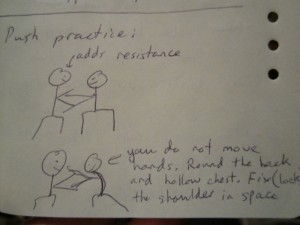
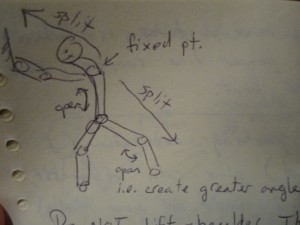
Fix shoulder in space – do not lift. This has to be like rubber band action where then shoulder is the fixed centre and everywhere else opens (stretches) as greatly as possible to lengthen your body. The goal is stretch out without any effort. - Do not move the waist and hand together. If anything, lock the waist and just move the hand. Again fix two dots in space and move 3rd one.
- Personal observation: when hand makes contact with partners body, twisting or flexing your fingers while everything else is locked easily manipulates even a strong person.
- We do not do universal post standing
- We do not talk about qi
- When doing Yilu, 7 min is the longest time allowed. Eventually aim for 3.5 min. But do not go fast until you are ready; you do not want to lose your structural integrity. If you want to go slow, do foundations.
- Do form as low and big as possible
- Can throw in fajin, but be consistent in your system: do same set of fajins for a while, then gradually increase.
- Proper energy alignment should eventually feel effortless. Any external shaking and/or leaking is bad. Water flowing through pipes, the pipe network should ideally be rigid (not moving), that way you know water is flowing ok; shaking pipes means loss of proper flow.
Get grinding! someday you’ll be sharp enough that someone will look at you and will cut themselves. – Allan




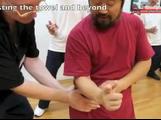
{ 4 comments… read them below or add one }
Allan,
Thanks for the great post. But I do have a question:
Can you further elaborate on “you just bring it to the line established by the 2 pts to snap it”?
“Snap” it?
As if snapping or breaking a very tightly stretched rubber band with the touch of your finger.
Allan,thanks for sharing the detailed notes. There are lots valuable teachings. Everyone can find something that can help his training.
great article Allan, informative read!